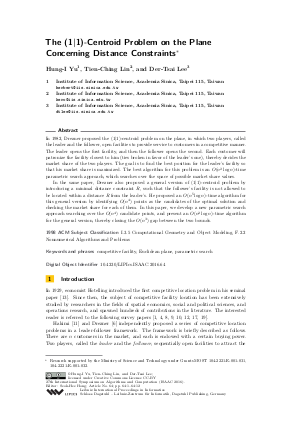The (1|1)-Centroid Problem on the Plane Concerning Distance Constraints
Authors Hung-I Yu, Tien-Ching Lin, Der-Tsai Lee
-
Part of:
Volume:
27th International Symposium on Algorithms and Computation (ISAAC 2016)
Part of: Series: Leibniz International Proceedings in Informatics (LIPIcs)
Part of: Conference: International Symposium on Algorithms and Computation (ISAAC) - License:
 Creative Commons Attribution 3.0 Unported license
Creative Commons Attribution 3.0 Unported license
- Publication Date: 2016-12-07
File

PDF
LIPIcs.ISAAC.2016.64.pdf
- Filesize: 457 kB
- 12 pages
Document Identifiers
Subject Classification
Keywords
- competitive facility
- Euclidean plane
- parametric search
Metrics
- Access Statistics
-
Total Accesses (updated on a weekly basis)
0Document
0Metadata
Abstract
In 1982, Drezner proposed the (1|1)-centroid problem on the plane, in which two players, called the leader and the follower, open facilities to provide service to customers in a competitive manner. The leader opens the first facility, and then the follower opens the second. Each customer will patronize the facility closest to him (ties broken in favor of the leader's one), thereby decides the market share of the two players. The goal is to find the best position for the leader’s facility so that his market share is maximized. The best algorithm for this problem is an O(n^2 log n)-time parametric search approach, which searches over the space of possible market share values. In the same paper, Drezner also proposed a general version of (1|1)-centroid problem by introducing a minimal distance constraint R, such that the follower's facility is not allowed to be located within a distance R from the leader's. He proposed an O(n^5 log n)-time algorithm for this general version by identifying O(n^4) points as the candidates of the optimal solution and checking the market share for each of them. In this paper, we develop a new parametric search approach searching over the O(n^4) candidate points, and present an O(n^2 log n)-time algorithm for the general version, thereby closing the O(n^3) gap between the two bounds.
Cite As Get BibTex
Hung-I Yu, Tien-Ching Lin, and Der-Tsai Lee. The (1|1)-Centroid Problem on the Plane Concerning Distance Constraints. In 27th International Symposium on Algorithms and Computation (ISAAC 2016). Leibniz International Proceedings in Informatics (LIPIcs), Volume 64, pp. 64:1-64:12, Schloss Dagstuhl – Leibniz-Zentrum für Informatik (2016)
https://doi.org/10.4230/LIPIcs.ISAAC.2016.64
BibTex
@InProceedings{yu_et_al:LIPIcs.ISAAC.2016.64,
author = {Yu, Hung-I and Lin, Tien-Ching and Lee, Der-Tsai},
title = {{The (1|1)-Centroid Problem on the Plane Concerning Distance Constraints}},
booktitle = {27th International Symposium on Algorithms and Computation (ISAAC 2016)},
pages = {64:1--64:12},
series = {Leibniz International Proceedings in Informatics (LIPIcs)},
ISBN = {978-3-95977-026-2},
ISSN = {1868-8969},
year = {2016},
volume = {64},
editor = {Hong, Seok-Hee},
publisher = {Schloss Dagstuhl -- Leibniz-Zentrum f{\"u}r Informatik},
address = {Dagstuhl, Germany},
URL = {https://drops.dagstuhl.de/entities/document/10.4230/LIPIcs.ISAAC.2016.64},
URN = {urn:nbn:de:0030-drops-68337},
doi = {10.4230/LIPIcs.ISAAC.2016.64},
annote = {Keywords: competitive facility, Euclidean plane, parametric search}
}
Author Details
References
-
Aritra Banik, Jean-Lou De Carufel, Anil Maheshwari, and Michiel Smid. Discrete voronoi games and ε-nets, in two and three dimensions. Computational Geometry, 55:41-58, 2016.

-
Richard Cole. Slowing down sorting networks to obtain faster sorting algorithms. Journal of the ACM, 34(1):200-208, January 1987.

-
Richard Cole. Parallel merge sort. SIAM Journal on Computing, 17(4):770-785, 1988.

-
Abdullah Dasci. Conditional location problems on networks and in the plane. In Horst A. Eiselt and Vladimir Marianov, editors, Foundations of Location Analysis, pages 179-206. Springer US, Boston, MA, 2011.

-
Ivan Davydov, Yury Kochetov, and Alexandr Plyasunov. On the complexity of the (r|p)-centroid problem in the plane. TOP, 22(2):614-623, 2014.

-
Zvi Drezner. Competitive location strategies for two facilities. Regional Science and Urban Economics, 12(4):485-493, 1982.

-
Zvi Drezner and E. Zemel. Competitive location in the plane. Annals of Operations Research, 40(1):173-193, 1992.

-
Horst A. Eiselt and Gilbert Laporte. Sequential location problems. European Journal of Operational Research, 96(2):217-231, 1997.

-
Horst A. Eiselt, Gilbert Laporte, and Jacques-Francois Thisse. Competitive location models: a framework and bibliography. Transportation Science, 27(1):44-54, 1993.

-
Horst A. Eiselt, Vladimir Marianov, and Tammy Drezner. Competitive location models. In Gilbert Laporte, Stefan Nickel, and Francisco Saldanha da Gama, editors, Location Science, pages 365-398. Springer International Publishing, Cham, 2015.

-
S. Louis Hakimi. On locating new facilities in a competitive environment. European Journal of Operational Research, 12(1):29-35, 1983.

-
S. Louis Hakimi. Locations with spatial interactions: competitive locations and games. In Pitu B. Mirchandani and Richard L. Francis, editors, Discrete location theory, pages 439-478. Wiley, 1990.

-
Harold Hotelling. Stability in competition. The Economic Journal, 39(153):41-57, 1929.

-
D. T. Lee and Y. F. Wu. Geometric complexity of some location problems. Algorithmica, 1(1):193-211, 1986.

-
Nimrod Megiddo. Applying parallel computation algorithms in the design of serial algorithms. Journal of the ACM, 30(4):852-865, October 1983.

-
Nimrod Megiddo. Linear-time algorithms for linear programming in R³ and related problems. SIAM Journal on Computing, 12(4):759-776, 1983.

-
Frank Plastria. Static competitive facility location: An overview of optimisation approaches. European Journal of Operational Research, 129(3):461-470, 2001.

-
Angelika Reiser. A linear selection algorithm for sets of elements with weights. Information Processing Letters, 7(3):159-162, 1978.

-
D. R. Santos-Peñate, R. Suárez-Vega, and P. Dorta-González. The leader-follower location model. Networks and Spatial Economics, 7(1):45-61, 2007.

